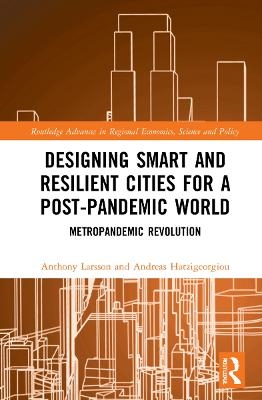
Designing Smart and Resilient Cities for a Post-Pandemic World
Routledge (Verlag)
978-1-032-11995-3 (ISBN)
Are pandemics the end of cities? Or, do they present an opportunity for us to reshape cities in ways making us even more innovative, successful and sustainable? Pandemics such as COVID-19 (and comparable disruptions) have caused intense debates over the future of cities.
Through a series of investigative studies, Designing Smart and Resilient Cities for a Post-Pandemic World: Metropandemic Revolution seeks to critically discuss and compare different cases, innovations and approaches as to how cities can utilise nascent and future digital technology and/or new strategies in order to build stronger resilience to better tackle comparable large-scale pandemics and/or disruptions in the future.
The authors identify ten separate societal areas where future digital technology can impact resilience. These are discussed in individual chapters. Each chapter concludes with a set of proposed "action points" based on the conclusions of each respective study. These serve as solid policy recommendations of what courses of action to take, to help increase the resilience in smart cities for each designated area. Securing resilience and cohesion between each area will bring about the metropandemic revolution.
This book features a foreword by Nobel laureate Peter C. Doherty and an afterword by Professor of Urban Technologies, Carlo Ratti. It provides fresh and unique insights on smart cities and futures studies in a pandemic context, offers profound reflections on contemporary societal functions and the needs to build resilience and combines lessons learned from historical pandemics with possibilities offered by future technology.
Anthony Larsson is an author, editor and researcher. He currently serves as Research Fellow at the Stockholm Chamber of Commerce, Sweden. Andreas Hatzigeorgiou is the CEO of the Stockholm Chamber of Commerce, Sweden, and is an affiliated researcher at the School of Architecture and the Built Environment, KTH Royal Institute of Technology.
Outline: Overview 1. Introduction: Pandemic Resilience in Smart Cities – The Metropandemic Revolution PART I: Appeal 2. Attractiveness: How to Make a Smart City Revitalise Its Charm during and after a Pandemic 3. Labour: The Smart City and Pre-and Post-Pandemic Job Opportunities 4. Housing: Past and Future Living PART II: Facilities 5. Infrastructure and Travel: Travelling Safe in the Future 6. Welfare and Healthcare: The View on Health and Wellness in the Future 7. Global Hubs: Setting Up and Sustaining International Businesses in Smart Cities in Times of Pandemics PART III: Durability 8. Digitalisation: Optimising a Pandemic and Post-Pandemic Smart City 9. Safety and Security: Identifying and Addressing Crime in a Pandemic Smart City 10. Sustainability: Ensuring Urban Sustainability for Smart Cities during and after Pandemics Conclusion 11. Cohesion: The Metropandemic Revolution and Beyond
| Erscheinungsdatum | 01.09.2022 |
|---|---|
| Reihe/Serie | Routledge Advances in Regional Economics, Science and Policy |
| Zusatzinfo | 3 Tables, black and white; 2 Line drawings, black and white; 23 Halftones, black and white; 25 Illustrations, black and white |
| Verlagsort | London |
| Sprache | englisch |
| Maße | 156 x 234 mm |
| Gewicht | 453 g |
| Themenwelt | Studium ► Querschnittsbereiche ► Infektiologie / Immunologie |
| Naturwissenschaften ► Biologie ► Ökologie / Naturschutz | |
| Naturwissenschaften ► Geowissenschaften ► Geografie / Kartografie | |
| Sozialwissenschaften ► Soziologie | |
| Wirtschaft ► Betriebswirtschaft / Management ► Unternehmensführung / Management | |
| Wirtschaft ► Volkswirtschaftslehre | |
| ISBN-10 | 1-032-11995-0 / 1032119950 |
| ISBN-13 | 978-1-032-11995-3 / 9781032119953 |
| Zustand | Neuware |
| Haben Sie eine Frage zum Produkt? |
aus dem Bereich


